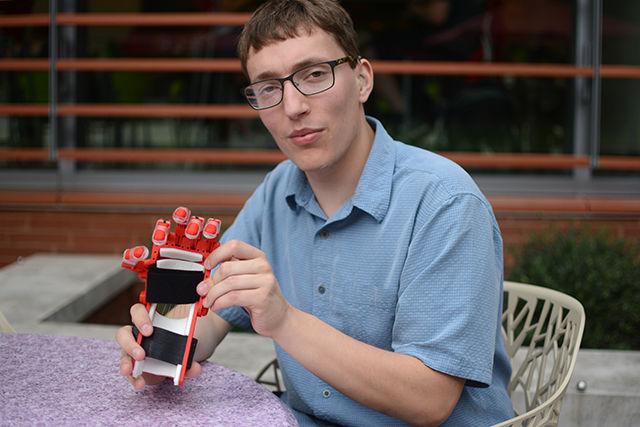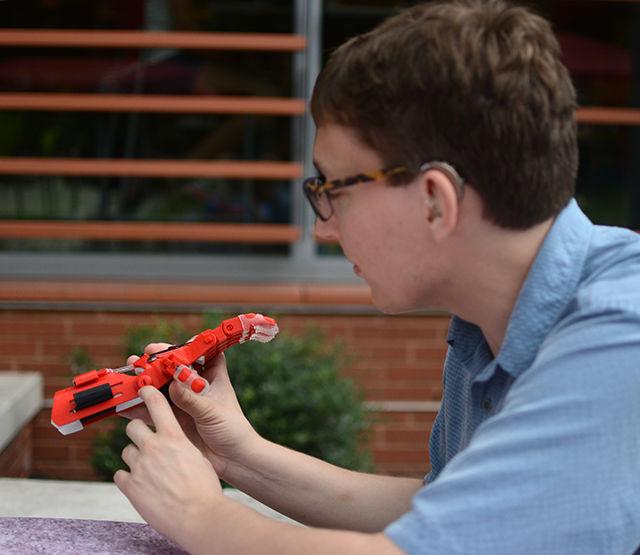It all began when a professor connected Jeff Powell, a biomedical engineering student at UNC-Chapel Hill, with Holden Mora, a 7-year-old boy born with symbrachydactyly, a condition that causes hands to stop growing early on in amniotic development. The Helping Hand Project, a student club, and now a nonprofit, grew out of that interaction and now has provided 3-D printed prosthetic hands to 21 children at no cost to them. Powell, now a UNC-CH graduate, founded the club and now is president of the nonprofit as well.
The club at UNC-CH, officially autonomous from the Biomedical Engineering Club this year, primarily works with the design, printing, assembling of the prosthetics and expansion to other colleges like NC State. The nonprofit section of the Helping Hand Project focuses on event planning, fundraising and overall organizing.
“I started the group because I saw an opportunity for engineering students like myself to use their time and skills in a meaningful way,” Powell said.
Currently, the group uses an open-source design, one that was created and published publically online for different people to use as they please, to print and assemble the hands. Members meet with the children to assess their hands and specific needs before printing the prosthetics, and the prosthetics often go through several rounds of development to achieve maximum comfort and efficiency.
“When the kids have these hands, they are able to not hide their hand,” Powell said, “They can show it to their friends and to new people as this really cool thing that they have. I’ve heard from multiple parents that kids have used it as a talking point when starting a new grade.”
Each child gets to choose the color of their prosthetic and Powell added that they have even made one that is glow-in-the-dark.
The designing, printing and assembling of the hand occurs in several different phases and relies heavily on student volunteering and word of mouth. First, any family interested in obtaining a free 3-D-printed prosthetic hand has to contact the Helping Hand Project through its website. The family is asked to enter basic information about their child’s condition and provide a few pictures so that the club can begin making modifications to their design template.
After the club receives a request, the leaders will assign that specific project to a group of five or six students who will contact the family, get measurements of the child’s hand and arm, watch videos on how the child moves his or her hand, and gather more detailed information about the child’s condition. Once this information is gathered, the students often use the modeling software Solidworks to create an online mold of the hand.
After making modifications to the open-source design and creating an online mold, the team prints the hand in different parts and assembles it by hand. Finally, the team contacts the family again and, if the family is nearby, the team schedule’s a meeting with them to assure that the hand fits, is comfortable and works properly as well. If it does, they send the child home with a new prosthetic hand. If not, the team works to make adjustments to the hand so that the child will have a prosthetic that fits comfortably and works properly.
Though the Helping Hand Project predominately works with the physical printing and assembling of the prosthetics, it also works on making connections between the children and families that have benefitted from the free prosthetics. The main way the project does this is by organizing and hosting three events each year to bring the children and their families together. It is a time for the children to have fun, get the support they need and meet other children with limb differences.
“Most kids with limb disabilities don’t know anyone else with a similar disability,” said Elliot Krause, a junior studying biomedical engineering at UNC-CH. “These get-togethers provide the children with opportunities to view their disability in a positive light.”
After meeting other children, instead of viewing their limb difference as a negative difference, they turn it into something positive.
“They don’t just call themselves Iron Man, they think of themselves as Iron Man,” Krause said.
Krause, now president of the Helping Hand Club at UNC-CH, wants to focus on expanding the club to other colleges, compiling the club’s resources online and working on more custom designs.
“I just want to maximize the number of kids we reach,” Krause said. “My role has been helping build the club that builds hands.”
The club at UNC-CH now has about 60 members, and they are currently working on creating chapters at NC State and UNC–CH as well. Since the biomedical engineering program at NC State is a joint program with UNC-CH, the Helping Hand Project quickly expanded to NC State.
Powell believes that NC State has much to offer to the project.
“One of benefits that I could see the NC State chapter having to the mission as a whole is that State is a more traditional engineering school and would probably have more students willing to volunteer with different skills,” Powell said. “That could really help with the custom designs.”
Krause said he has high hopes for the NC State chapter because of NC State’s high-quality 3-D printers and engineering talent.
While Krause is working on compiling all files and methods into a Google Drive to share with other chapters, Emily Fawcett, vice president of the Helping Hand chapter at State, is helping organize volunteers and lay the foundation for the club.
“The club is official but still in the early stages of getting set up,” Fawcett said. ”Our goal for this year is to be able to make at least two 3-D printed hands for children currently on the waiting list. It would be great if we could get a few more done, but since the club is new and we are still learning the process, we are hoping for at least two.”
The NC State chapter already has about 40 students interested in joining. Fawcett hopes to get two teams of four students each in the fall to learn the process and start making a hand. In the spring, she hopes to have more people join and have the people already in the club help teach them the methods and process as well.
“The officers of the club take a lot of joy in being able to help others and this club has been the perfect way to do that,” Fawcett said.
While the Helping Hand Project is only about two years old, it has already provided hope and opportunity for many children with limb differences. Just the printing, assembling and distributing of a free prosthetic is a major undertaking and extremely beneficial to the children and their families, but the club and its volunteers don’t stop there. They want the children to view their limb difference in a positive light and give them something that they can be proud of. They want to connect those children, who have lived with being “different” their whole lives, to other children and families that can understand and support them.
In other words, the club does more than provide a free prosthetic to children in need. It also provides hope, makes connections and supplies unconditional support that helps the children grow in their difference and gain confidence and pride in themselves.
“We want to give them a device that they can be proud about,” Powell said. “Something related to their condition that they can be proud about and express their condition in a positive way with.”
On Nov. 11, the Helping Hand Project is planning a Benefit Concert to raise money for the printing of the prosthetics. They’re doing this both through ticket sales and corporate sponsorships. The concert will feature local bands and will be held at Forest Cedar in Chapel Hill.
Elliot Krause, a junior studying biomedical engineering at UNC-Chapel Hill and the president of Helping Hands, shows off a prosthetic device made by the Helping Hands club at UNC-CH. Helping Hands is non-profit organization based at UNC-CH that makes prosthetic devices for children at no cost to families. The parts of the prosthetic are 3D printed and assembled with other materials such as string and elastic that allow them to move.









